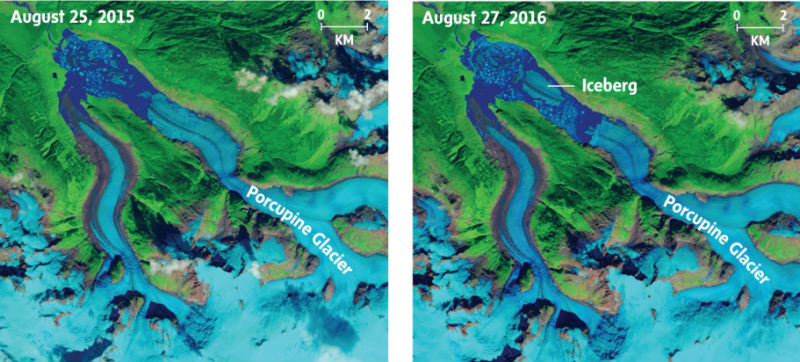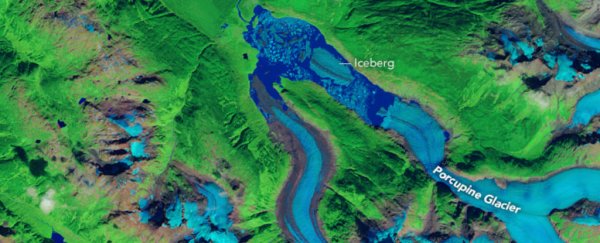On 27 August 2016, something monumental happened - the single largest iceberg in decades broke free from the Porcupine Glacier in Canada, and it's now floating freely in the icefields of northern British Columbia.
What's particularly scary about this event isn't the fact that this massive glacier is now officially starting to break apart - it's that it took us almost two months to notice what's been described as "the biggest calving event in North America" in recent memory.
Until recently, significant glacier fractures like this didn't really happen in North America, but in over the past few decades, they've been increasing in frequency.
The event was just picked up by glaciologist and director of the North Cascades Glacier Climate Project, Mauri Pelto, who's been pouring through satellite imagery of glaciers that have been captured by NASA since the 1980s.
He noticed that on August 27, the Landsat 8 satellite passed over the Porcupine Glacier and took shots of a large, undocumented iceberg.
When Pelto compared the image to a satellite shot of the same area from 27 August 2015, he realised that massive iceberg was, until very recently, a part of the Porcupine Glacier.
You can see the comparison below, and why the iceberg - when it was attached - was referred to as the Porcupine Glacier's 'tongue':
 NASA
NASA
While the Columbia Glacier in Alaska has lost more ice by volume in recent years, Pelto says the breakup at Porcupine is the largest single iceberg by area to split from a North American glacier in recent decades.
The iceberg has been estimated to cover around 1.2 square km (0.74 square miles).
"I knew it would be a good time to look at the glacier. I hadn't looked in maybe two years at the satellite imagery at the end of [the tongue], and it looked poised for a breakup. So I looked," Pelto told Mark Hume at The Globe and Mail.
"I was just expecting to see a decent retreat of the glacier and, of course as it happened. What was unusual was just the size of the iceberg that calved off there."
Major fractures like this occur when the glacial ice thins as it melts from above and below, and this makes it more susceptible to rifts. These rifts start to get deeper and deeper, and eventually, icebergs break off along the cracks.
And the bad news is we're going to have to get used to our icefields and polar regions undergoing massive changes due to ice thinning, because in case you hadn't noticed, Earth has been getting real hot.
Back in August, scientists reported that a massive crack in one of the world's largest ice shelves has been getting progressively bigger, and an iceberg the size of Delaware is threatening to break free and give us the third largest loss of Antarctic ice in history.
And a few weeks prior to that, reports of thousands of pristine blue lakes appearing on the ice sheets of East Antarctica, got everyone really worried, because scientists have seen this kind of thing happen before.
As we reported earlier, Greenland's ice sheet has been disintegrating rapidly, losing a whopping 1 trillion tonnes of ice between 2011 and 2014 - and research suggests it's because of these lakes.
Yep, Earth is melting, everybody.
Pelto says what's happened in the Porcupine is pretty monumental in scale, but glaciers are shedding icebergs all the time now. And if we're not willing to do what it takes to slow the retreat of what's left of the world's glaciers, we'd better be there to watch the fall.
"It's just a highlight example of what's happening," says Pelto. "I could list 100 glaciers that are doing a similar thing in terms of the rate of retreat in the last 20 years, that are within a couple hundred miles of that location. And so it is just one example."
